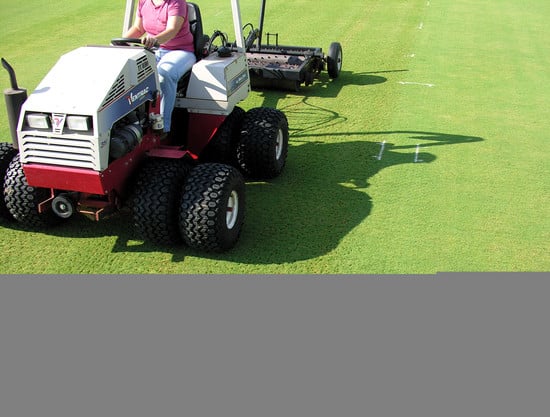Creeping Bentgrass Fairway Wear Resistance by Granular Topdressing of Ca/Mg-rich Liming Agents
Abstract
1. Introduction
2. Materials and Methods
3. Results
3.1. Soil pH and Silicon Availability
3.2. Turfgrass Vigor, Si Assimilation, Leaf H2O Status, and Nutrition
3.3. Turfgrass Traffic/Wear Tolerance
4. Discussion
4.1. Soil pH and Silicon Availability
4.2. Turfgrass Vigor, Si Assimilation, Leaf H2O Status, and Nutrition
4.3. Turfgrass Traffic/Wear Tolerance
5. Conclusions
Author Contributions
Funding
Acknowledgments
Conflicts of Interest
References
- Poldervaart, A. Chemistry of the Earth’s crust. Geol. Soc. Am. Spec. Pap. 1955, 62, 119–144. [Google Scholar]
- Coskun, D.; Deshmukh, R.; Sonah, H.; Menzies, J.G.; Reynolds, O.; Ma, J.F.; Kronzucker, H.J.; Belanger, R.R. The controversies of silicon’s role in plant biology. New Phytol. 2019, 221, 67–85. [Google Scholar] [CrossRef]
- Sangster, A.G.; Hodson, M.J.; Tubb, H.J. Silicon deposition in higher plants. In Silicon in Agriculture; Elsevier Science: New York, NY, USA, 2001; pp. 85–113. [Google Scholar]
- Gong, H.J.; Randall, D.P.; Flowers, T.J. Silicon deposition in the root reduces sodium uptake in rice (Oryza sativa L.) seedlings by reducing bypass flow. Plant Cell Environ. 2006, 29, 1970–1979. [Google Scholar] [CrossRef]
- Soukup, M.; Martinka, M.; Cigán, M.; Ravaszová, F.; Lux, A. New method for visualization of silica phytoliths in Sorghum bicolor roots by fluorescence microscopy revealed silicate concentration-dependent phytolith formation. Planta 2014, 240, 1365–1372. [Google Scholar] [CrossRef] [PubMed]
- Liang, Y.M.; Nikoli’c, M.; Bélanger, R.R.; Gong, H.; Song, A. Silicon in Agriculture: From Theory to Practice; Dordrecht-Springer: Dordrecht, The Netherlands, 2015; pp. 138–215. [Google Scholar]
- Lux, A.; Luxová, M.; Abe, J.; Morita, S.; Inanaga, S. Silicification of bamboo (Phyllostachys heterocycla Mitf.) root and leaf. Plant Soil 2003, 255, 85–91. [Google Scholar] [CrossRef]
- Guntzer, F.; Keller, C.; Poulton, P.R.; Mcgrath, S.P.; Meunier, J.-D. Long-term removal of wheat decreases soil amorphous silica at Broadbalk, Rothamsted. Plant Soil 2012, 352, 173–184. [Google Scholar] [CrossRef]
- Korndorfer, G.H.; Snyder, G.H.; Ulloa, M.; Powell, G.; Datnoff, L.E. Calibration of soil and plant silicon analysis for rice production. J. Plant Nutr. 2001, 24, 1071–1084. [Google Scholar] [CrossRef]
- Barbosa-Filho, M.P.; Snyder, G.H.; Elliot, C.L.; Datnoff, L.E. Evaluation of soil test procedures for determining rice-available silicon. Commun. Soil Sci. Plant Anal. 2001, 32, 1779–1792. [Google Scholar] [CrossRef]
- Nanayakkara, U.N.; Uddin, W.; Datnoff, L.E. Application of silicon sources increases silicon accumulation in perennial ryegrass turf on two soil types. Plant Soil 2008, 303, 83–94. [Google Scholar] [CrossRef]
- Datnoff, L.E.; Rutherford, B.A. Accumulation of silicon by bermudagrass to enhance disease suppression of leaf spot and melting out. USGA TERO 2003, 2, 1–8. [Google Scholar]
- Pruyne, D.P.; Schlossberg, M.J.; Uddin, W. Perennial ryegrass wear resistance and soil amendment by Ca- and Mg-silicates. Agronomy 2019, 9, 578. [Google Scholar] [CrossRef]
- Zhang, Q.; Fry, J.; Lowe, K.; Tisserat, N. Evaluation of calcium silicate for brown patch and dollar spot suppression on turfgrasses. Crop Sci. 2006, 46, 1635–1643. [Google Scholar] [CrossRef]
- Bae, E.J.; Kim, C.Y.; Yoon, J.H.; Lee, K.S.; Park, Y.B. Effect of silicate fertilizer application on zoysiagrass (Zoysia japonica Steud.) field. Weed Turfgrass Sci. 2018, 7, 247–257. [Google Scholar] [CrossRef]
- Trenholm, L.E.; Duncan, R.R.; Carrow, R.N.; Snyder, G.H. Influence of silica on growth, quality, and wear tolerance of seashore paspalum. J. Plant Nutr. 2001, 24, 245–259. [Google Scholar] [CrossRef]
- Redmond, C.T.; Potter, D.A. Silicon fertilization does not enhance creeping bentgrass resistance to cutworms and white grubs. Appl. Turfgrass Sci. 2006. [Google Scholar] [CrossRef]
- Uriarte, R.F.; Shew, H.D.; Bowman, D.C. Effect of soluble silica on brown patch and dollar spot of creeping bentgrass. J. Plant Nutr. 2004, 27, 325–339. [Google Scholar] [CrossRef]
- Barber, S.A. Liming materials and practices. In Soil Acidity and Liming, 2nd ed.; Agron. Monogr. 12; ASA, CSSA, and SSSA: Madison, WI, USA, 1984; pp. 171–209. [Google Scholar]
- Schlossberg, M.J.; Waltz, F.C.; Landschoot, P.J.; Park, B. Recent mechanical cultivation of lawns enhances lime application efficacy. Agron. J. 2008, 100, 855–861. [Google Scholar] [CrossRef]
- Soukup, M.; Martinka, M.; Bosnic, D.; Caplovicová, M.; Elbaum, R.; Lux, A. Formation of silica aggregates in sorghum root endodermis is pre-determined by cell wall architecture and development. Ann. Bot. 2017, 120, 739–753. [Google Scholar] [CrossRef]
- Canaway, P.M. Wear tolerance of turfgrass species. J. Sports Turf Res. Inst. 1981, 57, 65–83. [Google Scholar]
- Beard, J.B. Turfgrass Science and Culture; Prentice Hall: Englewood Cliffs, NJ, USA, 1973; pp. 368–465. [Google Scholar]
- He, C.; Wang, L.; Liu, J.; Liu, X.; Li, X.; Ma, J.; Lin, Y.; Xu, F. Evidence for ‘silicon’ within the cell walls of suspension-cultured rice cells. New Phytol. 2013, 200, 700–709. [Google Scholar] [CrossRef]
- Suzuki, S.; Ma, J.F.; Yamamoto, N.; Hattori, T.; Sakamoto, M.; Umezawa, T. Silicon deficiency promotes lignin accumulation in rice. Plant Biotechnol. 2012, 29, 391–394. [Google Scholar] [CrossRef]
- Yamamoto, T.; Nakamura, A.; Iwai, H.; Ishii, T.; Ma, J.F.; Yokoyama, R.; Nishitani, K.; Satoh, S.; Furukawa, J. Effect of silicon deficiency on secondary cell wall synthesis in rice leaf. J. Plant Res. 2012, 125, 771–779. [Google Scholar] [CrossRef] [PubMed]
- Kido, N.; Yokoyama, R.; Yamamoto, T.; Furukawa, J.; Iwai, H.; Satoh, S.; Nishitani, K. The matrix polysaccharide (1;3,1;4)-b-d-glucan is involved in silicon dependent strengthening of rice cell wall. Plant Cell Physiol. 2015, 56, 268–276. [Google Scholar] [CrossRef] [PubMed]
- Kaur, H.; Gregor, M. A review on Si uptake and transport system. Plants 2019, 8, 81. [Google Scholar] [CrossRef] [PubMed]
- Cockerham, S.T.; Brinkman, D.J. A simulator for cleated-shoe sports traffic on turfgrass research plots. Calif. Turfgrass Cult. 1989, 39, 9–12. [Google Scholar]
- Zhu, Q.; Schlossberg, M.J.; Bryant, R.B.; Schmidt, J.P. Creeping bentgrass putting green response to foliar nitrogen fertilization. Agron. J. 2012, 104, 1589–1594. [Google Scholar] [CrossRef]
- Schlossberg, M.J.; Karnok, K.J.; Landry, G. Estimation of viable root length density of heat-tolerant creeping bentgrass cultivars, ‘Crenshaw’ and ‘L93’, by an accumulative degree day model. J. Am. Soc. Hort. Sci. 2002, 127, 224–229. [Google Scholar] [CrossRef]
- Zhu, Q.; Schlossberg, M.J.; Bryant, R.B. Foliar fertilization-induced injury and recovery of a creeping bentgrass putting green. J. Plant Nutr. 2016, 39, 1589–1596. [Google Scholar] [CrossRef]
- Moody, D.R.; Schlossberg, M.J.; Archibald, D.D.; McNitt, A.S.; Fidanza, M.A. Soil water repellency development in amended sand rootzones. Crop Sci. 2009, 49, 1885–1892. [Google Scholar] [CrossRef]
- Guntzer, F.; Keller, C.; Meunier, J.D. Determining silicon concentration in plant material using Tiron extraction. New Phytol. 2010, 188, 902–906. [Google Scholar] [CrossRef]
- Karcher, D.E.; Richardson, M.D. Quantifying turfgrass color using digital image analysis. Crop Sci. 2003, 43, 943–951. [Google Scholar] [CrossRef]
- Carrow, R.N.; Waddington, D.V.; Rieke, P.E. Turfgrass Soil Fertility and Chemical Problems: Assessment & Management; Wiley & Sons: Hoboken, NJ, USA, 2001; pp. 16–348. [Google Scholar]
- McLarnon, E.; McQueen-Mason, S.; Lenk, I.; Hartley, S.E. Evidence for active uptake and deposition of Si-based defenses in tall fescue. Front. Plant Sci. 2017, 8, 1199. [Google Scholar] [CrossRef] [PubMed]
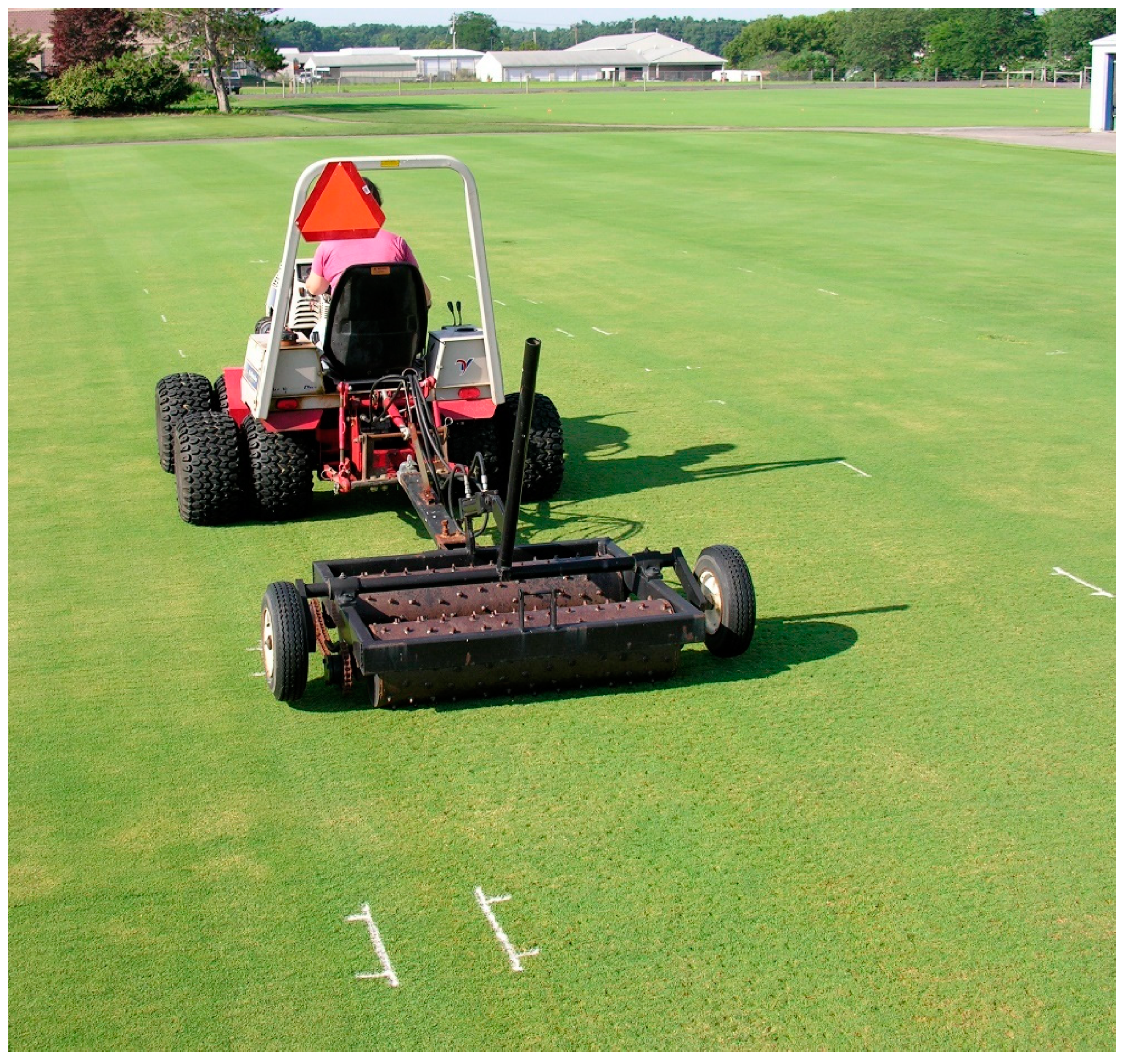
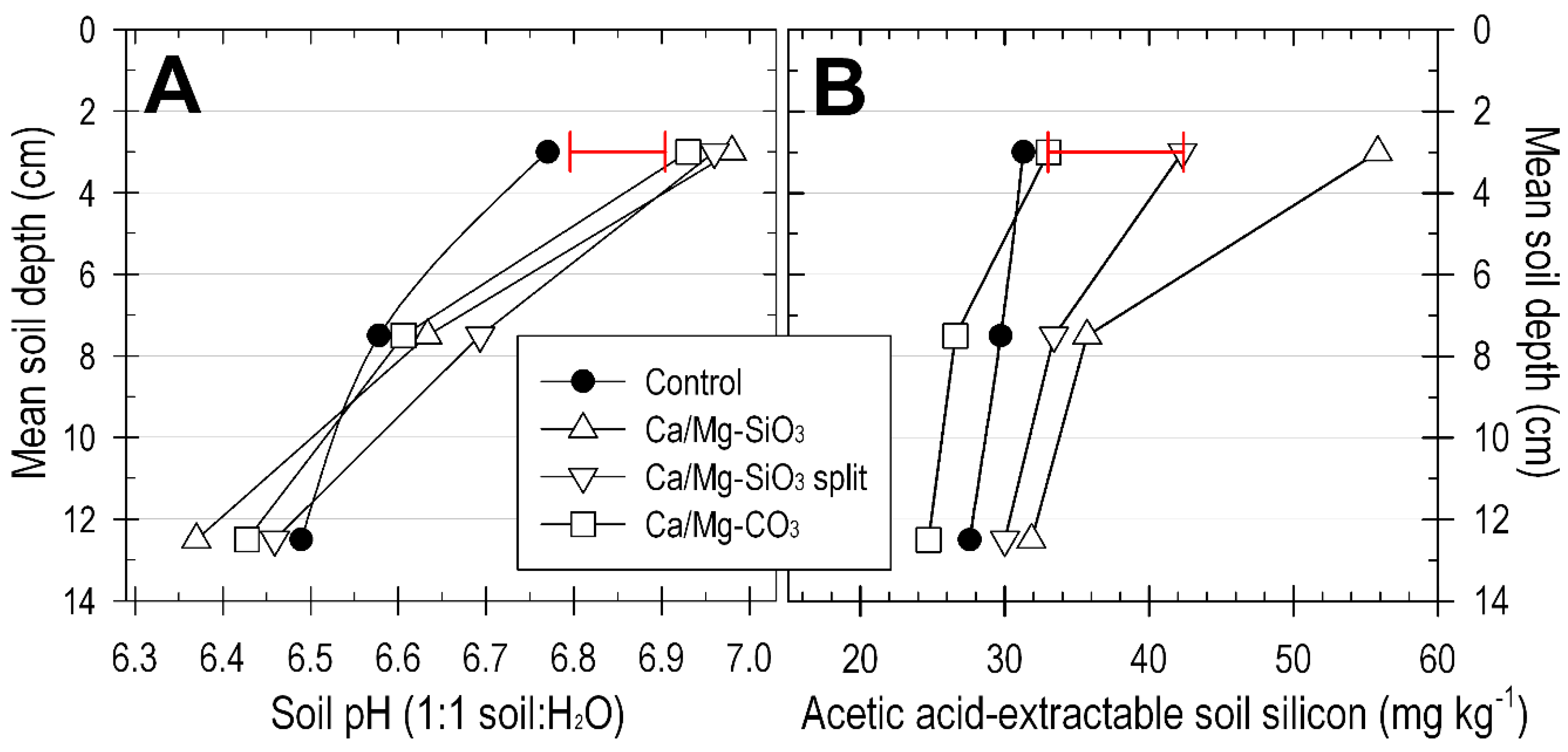
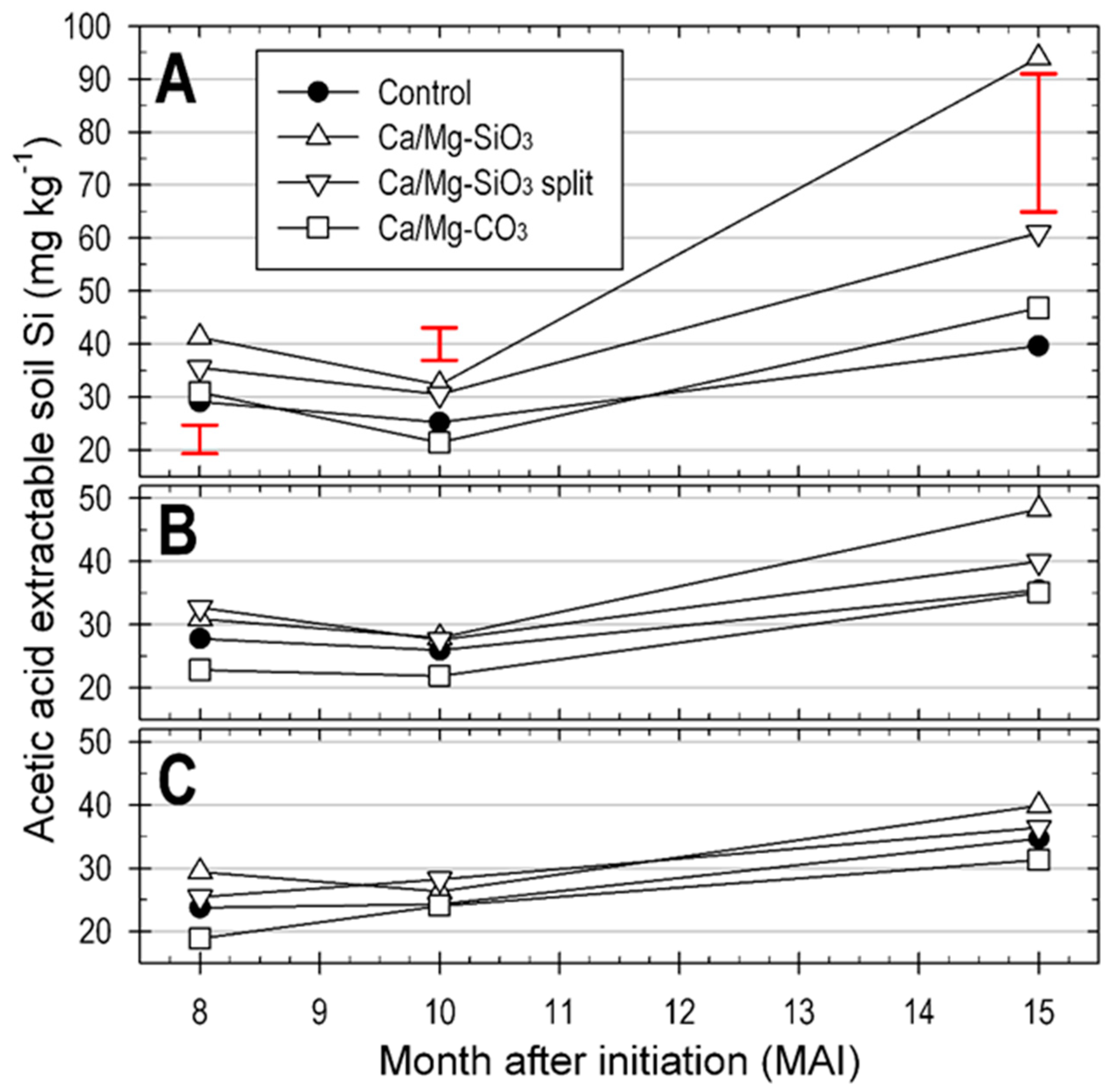
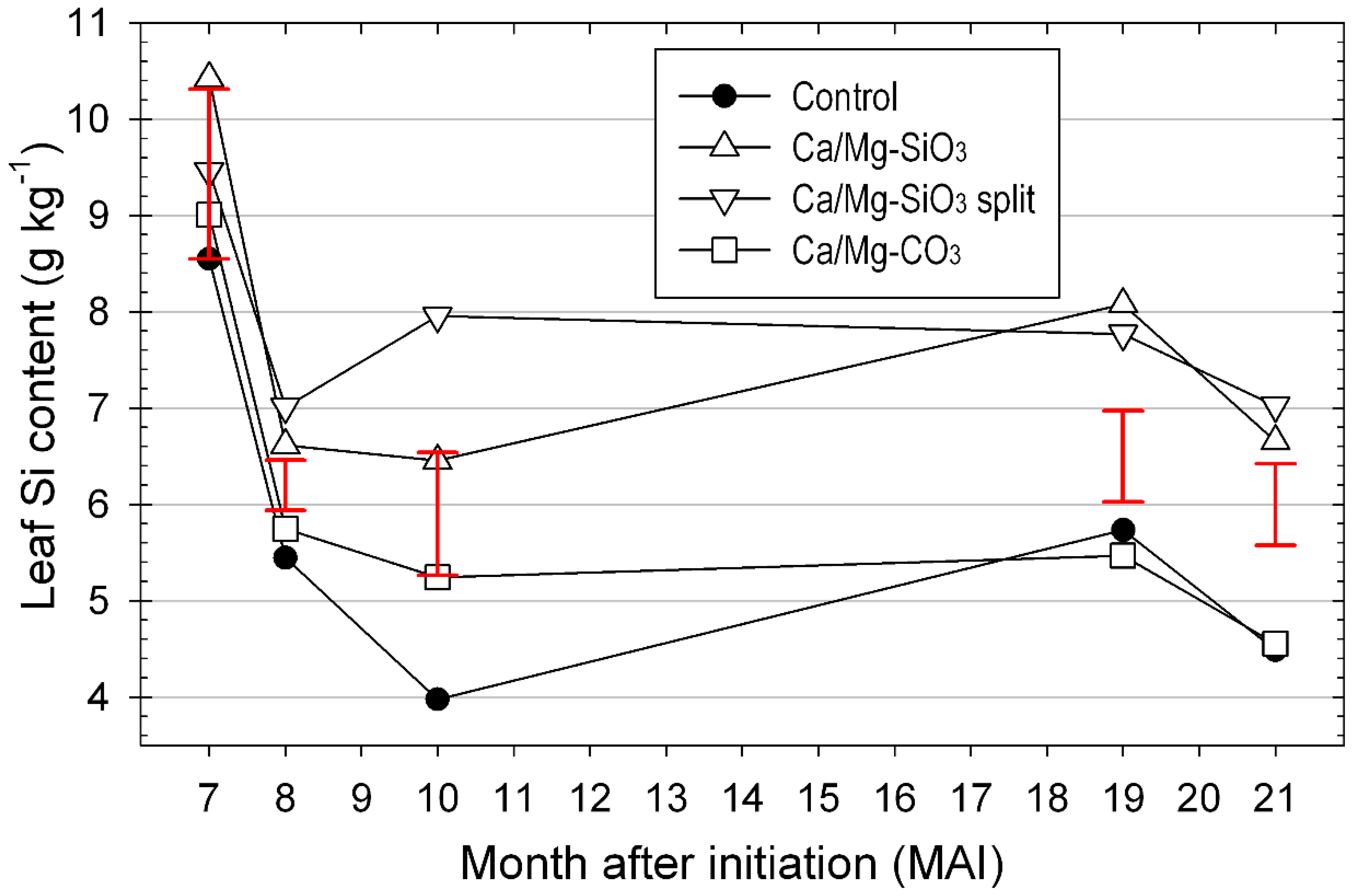
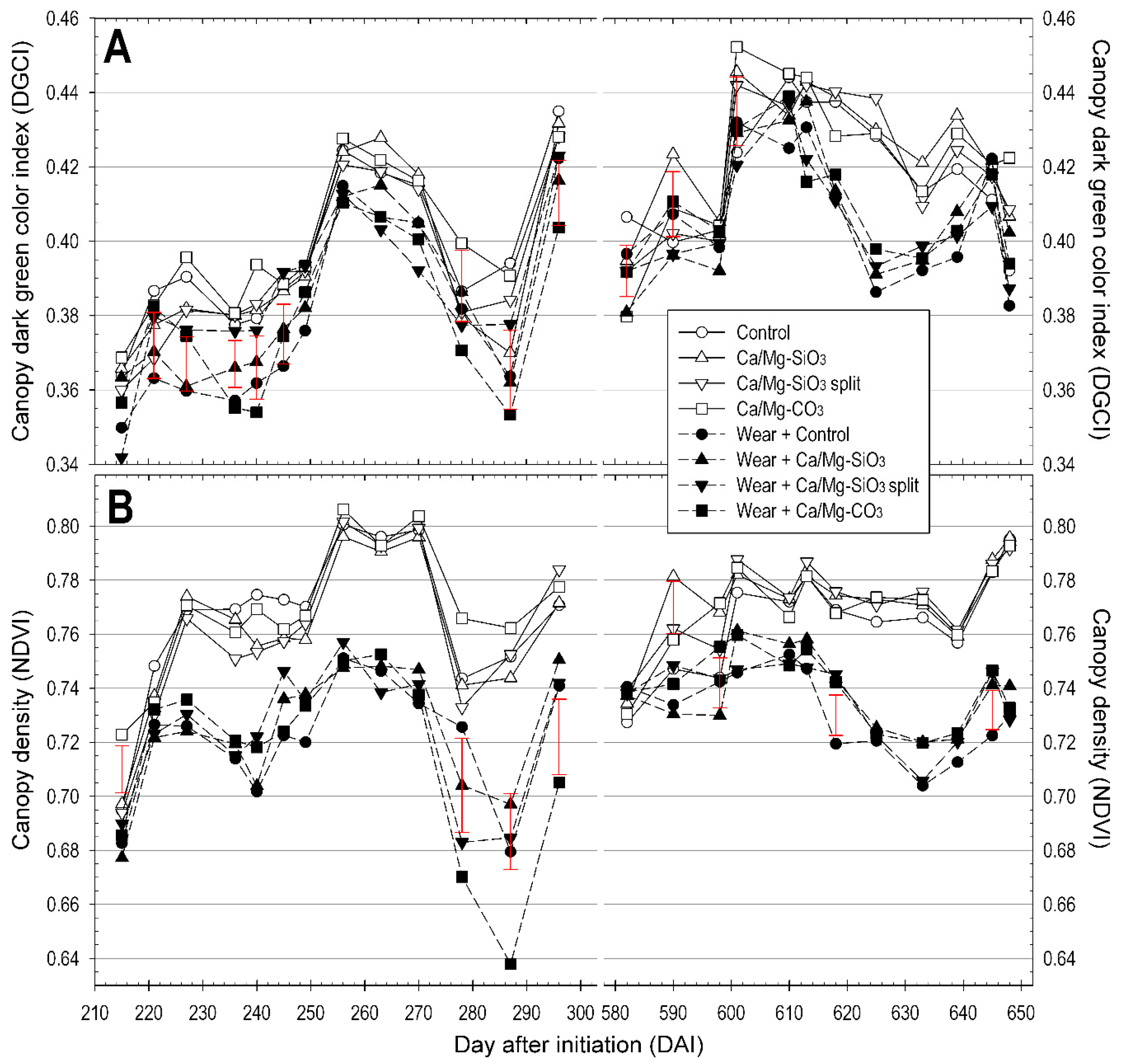
| Liming Agent | Ca | Cu | Fe | Mg | Mn | Si | CaCO3 Equiv. |
|---|---|---|---|---|---|---|---|
| g kg−1 | |||||||
| Harsco Minerals Ca/MgSiO3 | 240 | 5 | 18 | 60 | 5 | 250 | 790 |
| OldCastle pelletized Ca/MgCO3 | 265 | - | - | 60 | - | - | 940 |
| Source | df | 0 to 5 cm | 5 to 10 cm | 10 to 15 cm |
|---|---|---|---|---|
| Soil pH P (F-ratio < F-crit) | ||||
| Liming agent treatment (LAT) | 3 | 0.004 | 0.139 | 0.072 |
| Month after initiation (MAI) | 2 | 0.066 | 0.046 | 0.003 |
| LAT × MAI | 6 | 0.207 | 0.044 | 0.612 |
| Extractable Si P (F-ratio < F-crit) | ||||
| LAT | 3 | <0.001 | 0.195 | 0.427 |
| MAI | 2 | <0.001 | <0.001 | <0.001 |
| LAT × MAI | 6 | 0.040 | 0.359 | 0.930 |
| Source | df | Clipping Yield | Leaf Si | Si Offtake | df | Leaf H2O |
|---|---|---|---|---|---|---|
| P (F-ratio < F-crit) | ||||||
| Liming agent treatment (LAT) | 3 | 0.364 | <0.001 | 0.001 | 3 | 0.934 |
| Month after initiation (MAI) | 4 | <0.001 | <0.001 | <0.001 | 1 | <0.001 |
| LAT × MAI | 12 | 0.636 | 0.006 | 0.411 | 3 | 0.369 |
| LAT, 2440 kg (ha year)−1 | kg ha−1 | g kg−1 | g ha−1 | g kg−1 | ||
| Control | 9.88 | 5.64 | 57.78 | 751.8 | ||
| Ca/Mg–SiO3 | 10.76 | 7.65 | 83.74 | 751.4 | ||
| Ca/Mg–SiO3 SPL | 9.58 | 7.84 | 75.74 | 748.7 | ||
| Ca/Mg–CO3 | 9.97 | 6.00 | 59.63 | 750.0 | ||
| Least significant difference, alpha = 0.05 | - | 0.52 | 12.33 | - | ||
| Source | df | Canopy Color | Canopy Density |
|---|---|---|---|
| P (F-ratio < F-crit) | |||
| Wear | 1 | <0.001 | <0.001 |
| Liming agent treatment (LAT) | 3 | 0.310 | 0.560 |
| Wear × LAT | 3 | 0.265 | 0.469 |
| Day after initiation (DAI) | 24 | <0.001 | <0.001 |
| Wear × DAI | 24 | <0.001 | <0.001 |
| LAT × DAI | 72 | 0.007 | 0.105 |
| Wear × LAT × DAI | 72 | 0.005 | 0.019 |
© 2020 by the authors. Licensee MDPI, Basel, Switzerland. This article is an open access article distributed under the terms and conditions of the Creative Commons Attribution (CC BY) license (http://creativecommons.org/licenses/by/4.0/).
Share and Cite
Pruyne, D.T.; Schlossberg, M.J.; Uddin, W. Creeping Bentgrass Fairway Wear Resistance by Granular Topdressing of Ca/Mg-rich Liming Agents. Agriculture 2020, 10, 43. https://doi.org/10.3390/agriculture10020043
Pruyne DT, Schlossberg MJ, Uddin W. Creeping Bentgrass Fairway Wear Resistance by Granular Topdressing of Ca/Mg-rich Liming Agents. Agriculture. 2020; 10(2):43. https://doi.org/10.3390/agriculture10020043
Chicago/Turabian StylePruyne, Derek T., Maxim J. Schlossberg, and Wakar Uddin. 2020. "Creeping Bentgrass Fairway Wear Resistance by Granular Topdressing of Ca/Mg-rich Liming Agents" Agriculture 10, no. 2: 43. https://doi.org/10.3390/agriculture10020043
APA StylePruyne, D. T., Schlossberg, M. J., & Uddin, W. (2020). Creeping Bentgrass Fairway Wear Resistance by Granular Topdressing of Ca/Mg-rich Liming Agents. Agriculture, 10(2), 43. https://doi.org/10.3390/agriculture10020043




